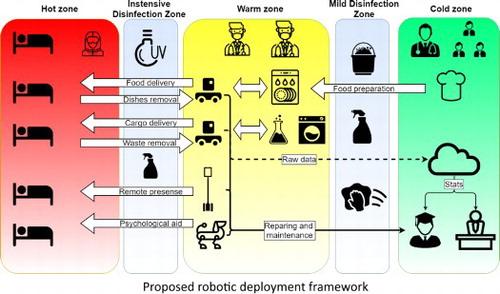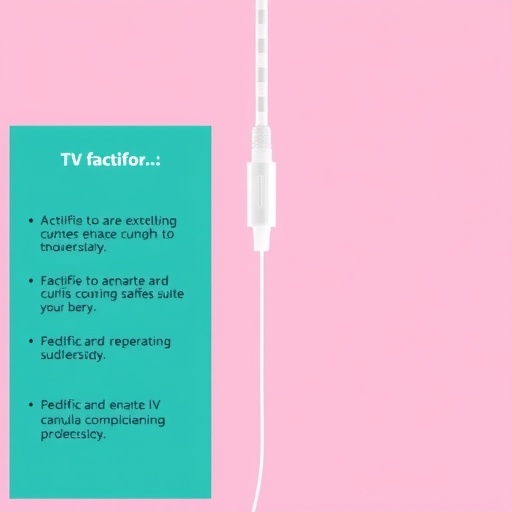A multidisciplinary team from Kazan Federal University published a paper in Advanced Robotics.

Credit: Kazan Federal University
In December 2019, a new viral infection was detected in Wuhan, China. On January 30, 2020, the World Health Organization declared the outbreak a public health emergency of international concern, and on March 11, the COVID-19 pandemic. In light of the danger that the infection poses to human personnel, the idea to utilize automation in hospitals is one of the natural solutions in healthcare.
Among the paper’s five co-authors, four are working in robotics and one is an expert in medicine. The paper presents a new concept of an infectious hospital that may become a worldwide standard in the future. The idea of this appeared while the authors were witnessing a quick spread of the Covid-19 and non-systematic attempts of most technologically developed countries of Europe, Asia, and America to employ various robots in their reaction to this disaster.
The team comprises Evgeni Magid (Professor, Head of Intelligent Robotics Systems Lab), Aufar Zakiev (PhD student, Research Associate of the same lab), Tatyana Tsoy (PhD student, Research Associate of the same lab), Roman Lavrenov (Senior Lecturer, Institute of IT and Intelligent Systems), and Albert Rizvanov (Professor, Academician of the Tatarstan Academy of Science, Director of the Center for Precision and Regenerative Medicine).
Initially, the authors surveyed pandemics-related research papers that consider pandemic mitigation from IT, AI, and robotics standpoints. During this analysis, they discovered that most of existing papers about applying robotics for COVID-19 mitigation are surveys which just enumerate existing solutions, or, conversely, present a single technique or a few techniques in a point-wise manner. They went further and, based on the performed survey, proposed a new classification of robots with regards to their usage for pandemic needs (originally intended and adapted robots) and a new classification of such robots with regards to a required operator training.
The most important contribution of the paper is a novel holistic architecture of an infectious disease hospital that employs robotic tools, both existing ones and proposed future technologies. This holistic architecture could help to develop robots with practical applicability and allows designers to define their functions precisely.
The new infectious hospital framework preserves classical organizational structure of “hot”, “warm” and “cold” zones. The hot zone is the epicenter, which is the most dangerous location of a direct contact with infected patients that have confirmed cases of a disease; this zone has strong restrictions aimed at containing the infection strictly inside the zone. The warm zone contains medical facilities with indirect contact with an infection, e.g., medical wards, laboratory areas, blood banks, dietary and laundry services, personnel restrooms for short breaks, etc. Finally, the cold zone is a safe zone that includes places with a low risk of infection.
The researchers analyzed possible daily activities within the three zones and selected a number of tasks, mainly within the hot zone, which could be successfully performed by robots. Moreover, the initial survey analysis demonstrated that for many of these tasks, there already exist at least several robotic solutions. Therefore, a proposed precise definition of functions that could be performed by robots in an infectious hospital environment aims to help hospital managers to select proper solutions, which will make the hospital operation more efficient and safe for medical personnel. On the other hand, the proposed requirements for infectious hospital robots should help robotic companies to develop highly sought products. In addition, the paper discusses ethical issues of robotics applications, which should be taken seriously both by robot developers and decision-making customers (e.g., hospital managers); the former should ensure ethical guidelines of human-robot interaction and task-oriented strategies before manufacturing the product, and the latter should be aware of potential ethical conflicts while selecting particular products for particular tasks.
Robotics has a huge potential almost in every field of our life. The authors strongly believe that robots should gradually replace human personnel within a dangerous hot zone of an infectious hospital and perform routine tasks which do not require high-level medical skills or education. This can increase the safety of doctors and other medical staff, decrease the unnecessary physical and psychological burden, and partially close the existing shortage of medical personnel that was widely reported even before the beginning of the pandemic. The paper proposes not only a new architecture for an infectious hospital, but also a variety of particular tasks and practical recommendations of further robot integration.
In the future, the team plans to develop the proposed infectious hospital framework and to evaluate its practical application. Even for running such hospital within a simulation, a large amount of preliminary work should be performed, including development of new regulations, communication and control strategies, sensory data fusion and autonomous navigation algorithms, safe and ethical human-robot interaction strategies and dozens of other tasks. This is a huge-scale and long term multidisciplinary project that requires international collaboration and significant funding. National governments and the humankind in general have learned important lessons from the COVID-19 pandemic and, should this project receive support, we may be better prepared for another pandemic – which is happening sooner or later.
###
Media Contact
Yury Nurmeev
[email protected]
Original Source
https:/
Related Journal Article
http://dx.





